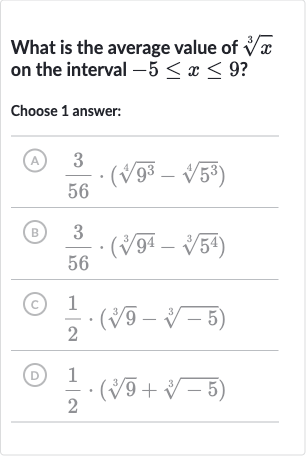Full solution
Q. What is the average value of on the interval ?Choose answer:(A) (B) (C) (D)
- Set up integral: To find the average value of a function on the interval , we use the formula:Average value = Here, , , and .
- Calculate interval length: First, we need to set up the integral to find the average value:Average value =
- Apply power rule: Calculate the denominator of the fraction, which is the length of the interval:
- Evaluate antiderivative: Now, the average value formula becomes:Average value =
- Substitute values: To integrate , we use the power rule for integration, which states that , where is the constant of integration. Here, .
- Find average value: Applying the power rule, we get:= =
- Match with options: Now we need to evaluate this antiderivative from to : from to =
- Match with options: Now we need to evaluate this antiderivative from to : from to Since we are dealing with real numbers, the cube root of a negative number is negative, and raising it to the fourth power will give us a positive result. So, is the same as , which is .
- Match with options: Now we need to evaluate this antiderivative from to :
from to
= Since we are dealing with real numbers, the cube root of a negative number is negative, and raising it to the fourth power will give us a positive result. So, is the same as , which is .Now we substitute the values into the expression: - Match with options: Now we need to evaluate this antiderivative from to :
from to
= Since we are dealing with real numbers, the cube root of a negative number is negative, and raising it to the fourth power will give us a positive result. So, is the same as , which is .Now we substitute the values into the expression:
Finally, we multiply this by the reciprocal of the interval length to find the average value:
Average value =
= - Match with options: Now we need to evaluate this antiderivative from to :
from to
= Since we are dealing with real numbers, the cube root of a negative number is negative, and raising it to the fourth power will give us a positive result. So, is the same as , which is .Now we substitute the values into the expression:
Finally, we multiply this by the reciprocal of the interval length to find the average value:
Average value =
= We can now match our result with the given options. The correct answer is:
(B)
More problems from Multiplication with rational exponents
QuestionGet tutor help
QuestionGet tutor help
QuestionGet tutor help
QuestionGet tutor help
QuestionGet tutor help
QuestionGet tutor help
QuestionGet tutor help
QuestionGet tutor help
QuestionGet tutor help

